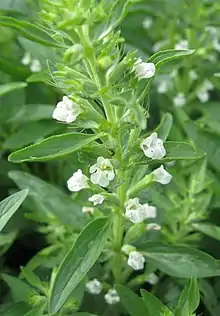Lallemantia iberica
Lallemantia iberica, known commonly as dragon's head, is a species of flowering plant in the mint family, Lamiaceae.
| Lallemantia iberica | |
|---|---|
 | |
| Lallemantia iberica | |
| Scientific classification | |
| Kingdom: | Plantae |
| Clade: | Tracheophytes |
| Clade: | Angiosperms |
| Clade: | Eudicots |
| Clade: | Asterids |
| Order: | Lamiales |
| Family: | Lamiaceae |
| Genus: | Lallemantia |
| Species: | L. iberica |
| Binomial name | |
| Lallemantia iberica (M.Bieb.) Fisch. & C.A.Mey. | |
The plant has been cultivated for its seeds in southwestern Asia and southeastern Europe since prehistoric times.[1] Its vernacular name in Iran is balangu shahri.[2] The seeds contain the edible oil known as lallemantia oil.[3] The oil content of the seeds is about 30%, sometimes reaching up to 38%. The oil is used as a substitute for linseed oil in the production of varnish, furniture polish, ink, paint, soap, and linoleum.[1]
Lallemantia iberica is famous for use in traditional medicines. This plant, originally from the Caucasus and the Middle East, spread throughout European and eastern countries.[4]
The seeds have been used in folk medicine as a stimulant and diuretic.[1] The leaves are used as a potherb in modern Iran.[5]
This plant is an annual herb growing to an average height around 40 cm (16 in). The toothed or serrated leaves are in opposite pairs at the stem nodes. Inflorescences emerge from the leaf axils and bear white, lipped flowers each about 1 cm (0.4 in) long. They are pollinated by insects.[1]
This species can escape cultivation and become a weed.[1]
Balanguseed mucilage (BSM) features many advantages over most of its polymer counterparts, including a lower production cost, higher efficiency, and better medicinal properties.[4]
References
- Ion, V.; Băşa, A.Gh.; Săndoiu, D.I.; Obrişcă, Mihaela (2011). "Results regarding biological characteristics of the species Lallemantia iberica in the specific conditions from South Romania" (PDF). UASVM Bucharest, Series A. 54: 275–80.
- Naghibi, Farzaneh; Mosaddegh, Mahmoud; Mohammadi Motamed, Saeed; Ghorbani, Abdolbaset (2005). "Labiatae Family in folk Medicine in Iran: from Ethnobotany to Pharmacology". Iranian Journal of Pharmaceutical Research. 4 (2): 63–79. doi:10.22037/ijpr.2010.619.
- Megaloudi, F. (2006). Plants and Diet in Greece from Neolithic to Classic Periods: the archaeobotanical remains. Oxford: Archaeopress. ISBN 1-84171-949-8.
- Sadeghi-Varkani, Atina; Emam-Djomeh, Zahra; Askari, Gholamreza (2017). "Physicochemical and microstructural properties of a novel edible film synthesized from Balangu seed mucilage". International Journal of Biological Macromolecules. 108: 1110–1119. doi:10.1016/j.ijbiomac.2017.11.029. PMID 29126944.
- Uphof, J. C. Th. (1968). Dictionary of Economic Plants. Lehre: Cramer.